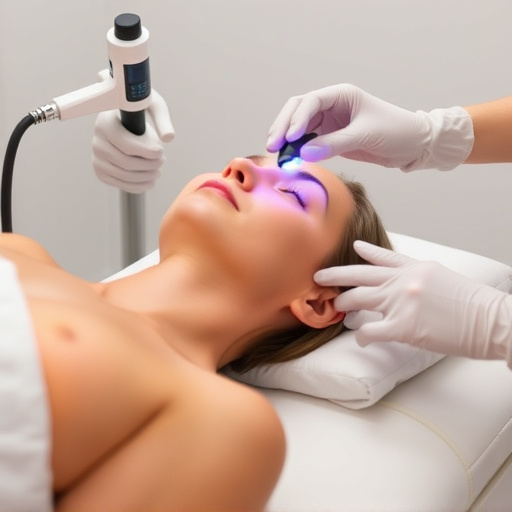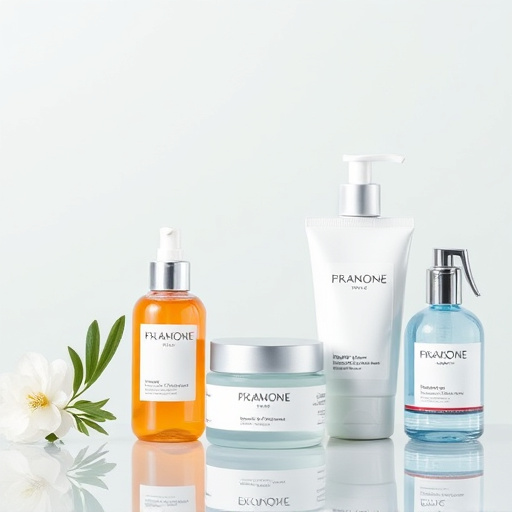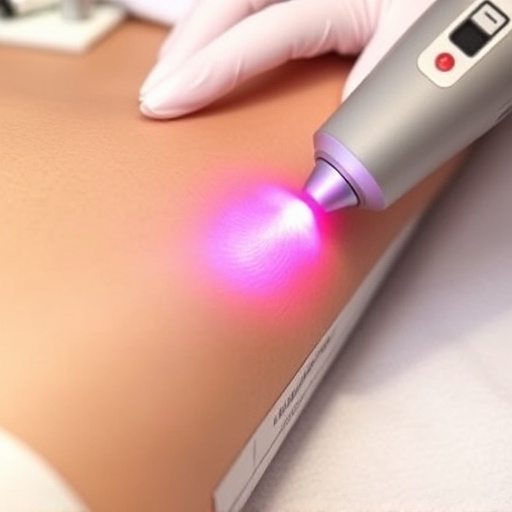Skin Tightening with Laser & Radiofrequency: Science-Backed Benefits and Risks
Skin tightening procedures using laser and radiofrequency technology have gained popularity as non-s…….
Welcome to an in-depth exploration of a transformative aesthetic practice: the skin tightening procedure. This article aims to guide readers through the intricate world of skin rejuvenation, offering insights into its definition, historical evolution, global reach, and future potential. By delving into various facets, from technological innovations to regulatory frameworks, we will uncover the significance of this procedure in the beauty and wellness industry.
Skin tightening has emerged as a sought-after solution for individuals seeking to reduce the appearance of skin laxity, fine lines, and wrinkles. This non-invasive to minimally invasive approach promises a youthful and toned complexion, capturing the interest of both cosmetic enthusiasts and medical professionals worldwide. As we navigate this article, you will gain a comprehensive understanding of why skin tightening has become a game-changer in the quest for radiant, firm skin.
Skin tightening is a cosmetic procedure that aims to improve the elasticity and firmness of the skin, particularly on the face, neck, and body. It involves a range of techniques, including advanced technologies, energy-based devices, and surgical methods, all designed to stimulate collagen production and promote skin rejuvenation. The core components typically include:
Collagen Stimulation: Activating the body’s natural collagen production is at the heart of many skin tightening treatments. Collagen, a structural protein, is essential for skin firmness and elasticity. By targeting specific tissue layers, these procedures encourage the body to generate new collagen fibers, leading to improved skin texture and reduced wrinkling.
Tissue Heating: Many modern skin tightening techniques utilize targeted heat delivery systems. This heating process helps to tighten the skin by causing controlled damage to the dermis, stimulating a healing response that results in firmer, smoother skin. Common methods include radiofrequency (RF) energy, laser technology, and intense pulsed light (IPL).
Non-Invasive and Minimally Invasive Approaches: While surgical options exist, most modern skin tightening procedures are non-invasive or minimally invasive. This means they do not require incisions or extensive recovery periods. Techniques like RF microneedling, ultrasonic tightening, and high-intensity focused ultrasound (HIFU) fall under this category, offering more accessible and faster recovery options.
The pursuit of achieving youthful skin has deep historical roots, dating back to ancient civilizations. However, the modern skin tightening procedure as we know it today has evolved significantly over the past few decades. Early attempts involved surgical facelifts and similar procedures, which carried extensive downtime and risks.
In the 1990s, the introduction of non-invasive techniques like Botox and collagen injections revolutionized the field. These advancements offered milder alternatives with shorter recovery times, sparking a surge in popularity. As technology advanced, newer methods emerged, such as RF ablation and laser resurfacing, further refining the skin tightening experience.
Today, the beauty industry boasts an extensive arsenal of tools and technologies dedicated to skin rejuvenation, catering to diverse needs and preferences. From at-home devices to clinical procedures, the market reflects a global fascination with maintaining youthful skin.
The skin tightening procedure has transcended geographical boundaries, captivating individuals from various cultural backgrounds. Its global impact is evident in the growing demand for these services across different regions:
North America: The United States and Canada lead in cosmetic procedures, including skin tightening. Advanced medical technologies and a highly specialized aesthetic industry have made non-invasive treatments increasingly popular.
Europe: Countries like Germany, France, and the United Kingdom are known for their advanced cosmetic medicine. European aesthetics prioritize safety and innovation, attracting patients seeking cutting-edge skin tightening options.
Asia Pacific: This region, encompassing China, Japan, and South Korea, has experienced a boom in cosmetic procedures. Rapid economic growth and a growing middle class have fueled the demand for aesthetic treatments, including skin tightening.
Latin America and Middle East: These regions are witnessing rising popularity of skin tightening due to increasing disposable incomes and a growing emphasis on personal grooming.
Several key trends contribute to the global impact and ongoing evolution of skin tightening procedures:
Non-Invasiveness and Minimal Downtime: The preference for non-invasive or minimally invasive treatments is a significant trend. Patients increasingly seek quick, convenient procedures with minimal recovery time, driving the adoption of advanced technologies like HIFU and RF microneedling.
Personalized Treatments: There is a growing demand for customized skin care solutions. Individuals want procedures tailored to their specific needs, skin type, and concerns, leading to more targeted treatments and product offerings.
At-Home Devices: The rise of at-home skin tightening devices has democratized access to these technologies. Consumers can now achieve some results in the comfort of their homes, sparking curiosity and trial among those hesitant to undergo clinical procedures.
Anti-Aging Focus: As the global population ages, the anti-aging market continues to grow. Skin tightening, being a key component of anti-aging strategies, is expected to see sustained demand as people strive to maintain youthful appearances.
The skin tightening procedure is not just a practice; it is a significant economic sector with substantial market potential. The global aesthetic industry, including skin care and rejuvenation treatments, has experienced remarkable growth in recent years. According to a report by Grand View Research, the global aesthetics market size was valued at USD 273.5 billion in 2021 and is expected to grow at a compound annual growth rate (CAGR) of 9.4% from 2022 to 2030.
Within this market, skin tightening procedures account for a substantial share due to their versatility and appeal across various demographics. The economic landscape is shaped by:
Increasing Discretionary Spending: Rising disposable incomes in developing economies have led to higher discretionary spending on beauty and wellness. This trend has significantly boosted the demand for premium aesthetic services, including skin tightening.
Medical Tourism: Cross-border medical travel, or medical tourism, is a growing phenomenon, particularly in regions known for their advanced cosmetic procedures. Skin tightening treatments often attract patients from around the world, contributing to local economies and fostering cultural exchange.
Franchise Opportunities: The franchising model has gained popularity in the aesthetic industry, allowing entrepreneurs to enter the market with established brands and support systems. This trend has led to a proliferation of skin tightening clinics, both independently and through franchise networks.
The economic viability of skin tightening procedures attracts significant investments from various sources:
Private Equity and Venture Capital: Investors recognize the potential for high returns in this sector. Startups developing innovative technologies or offering unique treatment approaches often secure funding to drive product development and market penetration.
Pharmaceutical Companies: Major pharmaceutical firms invest in cosmetic medicine, either through internal research or partnerships with aesthetic companies. They bring expertise in drug development and a deep understanding of skin biology, contributing to advancements in skin tightening treatments.
Medical Device Manufacturers: Companies specializing in medical devices play a crucial role by developing and commercializing cutting-edge equipment for skin tightening. These investments drive technological innovation, ensuring that procedures remain safe, effective, and accessible.
The landscape of skin tightening has been transformed by technological breakthroughs, each bringing unique advantages and addressing specific challenges. Some significant advancements include:
High-Intensity Focused Ultrasound (HIFU): HIFU technology uses concentrated ultrasound energy to target deep tissue layers without damaging the surface skin. This non-invasive procedure stimulates collagen production and elastsin fibers, leading to improved skin firmness and elasticity. HIFU is particularly effective for facial and neck tightening.
Radiofrequency (RF) Technology: RF devices emit electromagnetic waves to heat the dermis, triggering a collagen-stimulating response. Advanced RF systems, such as bipolar and unipolar devices, offer precise control over energy delivery, making them suitable for various skin concerns.
Laser Resurfacing: Laser technology has revolutionized skin tightening by allowing for precise removal of damaged skin cells and stimulation of collagen production. Fractional lasers, in particular, have gained popularity due to their ability to promote tissue regeneration while minimizing downtime.
Microneedling with RF or Ultrasound: Combining microneedling with RF or ultrasound energy amplifies the benefits of each technology. Microneedles create controlled micro-injuries, enhancing collagen and elastin production, while RF or ultrasound further stimulates healing and tightens the skin.
These technological advancements have had a profound impact on skin tightening procedures:
Improved Safety and Efficacy: Modern technologies offer enhanced safety profiles compared to earlier methods. With precise control over energy delivery, practitioners can target specific areas while minimizing damage to surrounding tissues. This results in better patient outcomes and reduced side effects.
Faster Recovery and Convenience: Non-invasive techniques, thanks to technological advancements, often allow patients to resume their normal activities sooner. At-home devices also contribute to this trend, enabling individuals to achieve some results without clinical visits.
Personalized Treatments: Advanced technologies enable practitioners to customize treatments based on individual needs. By analyzing skin types and concerns, they can tailor procedures, ensuring optimal results and patient satisfaction.
Global Accessibility: The digital age has made information and technologies more accessible worldwide. Online resources, training platforms, and remote consultations have contributed to the global dissemination of knowledge, enabling professionals in various regions to offer cutting-edge skin tightening services.
The skin tightening procedure operates within a complex web of policies and regulations, designed to ensure safety, efficacy, and ethical practices. These frameworks vary across jurisdictions but share common goals:
Licensing and Certification: Medical professionals performing skin tightening procedures must obtain licenses and certifications from regulatory bodies. These requirements ensure that practitioners meet specific educational, training, and competency standards.
Product Approvals: Cosmetic products, including skincare treatments and devices used in skin tightening, are subject to rigorous testing and approval processes. Regulatory authorities assess safety, efficacy, and quality before granting market authorization.
Informed Consent: Patients have the right to understand the procedure’s risks, benefits, and alternatives. Healthcare providers must obtain informed consent, ensuring patients are fully aware of what is involved and can make voluntary decisions.
Advertising and Marketing: Strict regulations govern the advertising of cosmetic procedures to prevent misleading claims and excessive promotion. These rules ensure that marketing materials provide accurate information about services and potential outcomes.
Policies and regulations play a pivotal role in shaping the skin tightening industry:
Standardization of Practices: Regulatory frameworks establish standards for safe and effective practices, ensuring consistency across healthcare providers. This standardization enhances patient confidence and enables comparability between different procedures and practitioners.
Innovation and Safety: Regulations encourage innovation by setting safety benchmarks. Companies developing new technologies must demonstrate the safety and efficacy of their products, driving advancements that meet or exceed regulatory standards.
Patient Protection: The primary focus of regulations is to protect patients from potential harm. By mandating proper training, informed consent, and product approvals, regulatory bodies ensure that individuals undergo procedures with minimal risks and maximized benefits.
Market Transparency: Clear regulatory guidelines promote transparency in the market. Patients can make informed choices by understanding the legal status and oversight of various skin tightening options.
Despite its growing popularity, the skin tightening procedure is not without challenges and criticisms. Addressing these issues is crucial for ensuring the procedure’s long-term viability and patient satisfaction:
Safety and Side Effects: One of the primary concerns revolves around potential risks and side effects. While modern technologies have reduced many hazards, some procedures may cause temporary redness, swelling, or discomfort. Rarer complications include infection, scarring, and pigment changes. Addressing these issues through thorough training, proper patient selection, and post-procedure care is essential.
Lack of Long-Term Studies: Critics often point to the relatively short-term nature of many clinical trials for skin tightening technologies. Extensive long-term studies are needed to fully comprehend the procedure’s effectiveness and potential late-onset side effects. Ongoing research and patient follow-up studies can provide valuable insights to address this concern.
High Costs and Accessibility: The financial aspect of skin tightening procedures has drawn criticism, with some considering them excessively expensive. While advanced technologies may come at a premium, the growing availability of at-home devices and affordable clinical options challenges this notion. Additionally, insurance coverage for these procedures varies, but increasing accessibility through innovative financing models is a developing trend.
Unrealistic Expectations: Misconceptions about what skin tightening can achieve are a significant challenge. Patients may expect immediate, dramatic results, leading to dissatisfaction if outcomes do not meet their expectations. Educating patients about the procedure’s limitations and potential benefits is crucial in setting realistic expectations.
Setting: A private dermatology clinic in Tokyo, Japan.
Procedure: High-Intensity Focused Ultrasound (HIFU) facial tightening using a cutting-edge HIFU device.
Results: The clinic treated 50 patients over six months, with an average age of 42. Post-procedure follow-ups revealed significant improvements in skin firmness and elasticity, with 90% of patients reporting satisfaction. The non-invasive nature of HIFU allowed patients to resume normal activities immediately, leading to high patient retention and positive word-of-mouth referrals.
Lessons Learned: HIFU’s ability to deliver precise, controlled energy makes it an effective and safe option for facial tightening, especially for individuals seeking minimal downtime procedures.
Setting: A cosmetic medical center in New York City, USA.
Procedure: Radiofrequency (RF) microneedling for body contouring, targeting fat reduction and skin tightening on the arms and abdomen.
Results: Over a year, the center treated 100 patients, achieving an average fat reduction of 25% and significant skin tightening. Patients appreciated the non-invasive nature and rapid recovery, with many noting improved confidence in their physical appearance.
Lessons Learned: RF microneedling offers a versatile solution for body contouring, addressing both fat reduction and skin firming concerns. The procedure’s popularity highlights the growing demand for non-surgical alternatives to invasive liposuction.
Setting: A specialist dermatology clinic in Sydney, Australia.
Procedure: Fractional laser resurfacing for scar revision on the face and neck.
Results: The clinic treated 75 patients with various types of scars, including acne scars and surgical scars. Post-treatment photographs demonstrated significant improvements, with an average scar reduction of 40%. Patients praised the procedure’s ability to enhance skin texture and reduce redness associated with old scars.
Lessons Learned: Laser resurfacing is a highly effective tool for scar revision, offering long-lasting results. The case load and patient satisfaction rates highlight the clinic’s expertise in this field and its growing demand among patients seeking non-surgical scar treatment options.
The skin tightening procedure is an ever-evolving field, with continuous innovation shaping its future:
Personalized Medicine: Advancements in genomics and biomarker research will enable personalized skin tightening treatments tailored to individual genetic profiles and skin types. This approach optimizes results and minimizes side effects.
Integration of AI and Machine Learning: Artificial intelligence (AI) has the potential to revolutionize skin analysis, treatment planning, and outcome prediction. AI-driven systems can process vast amounts of patient data, improving diagnostic accuracy and treatment selection.
Minimally Invasive and Nonsurgical Options: The demand for minimal or non-invasive procedures will continue to grow. Future innovations may include advanced microneedling techniques, improved ultrasound technologies, and novel chemical treatments that offer safe, effective alternatives to traditional surgical options.
Digital Delivery and Telemedicine: Digital platforms and telemedicine will play a more significant role in skin tightening, especially for follow-up consultations and remote patient monitoring. This trend expands access, particularly in underserved regions.
The skin tightening procedure has emerged as a thriving global industry, offering individuals effective solutions for achieving and maintaining youthful-looking skin. Technological advancements, economic viability, and evolving regulatory landscapes have contributed to its growth and accessibility. While challenges and criticisms exist, addressing these issues through research, education, and innovation ensures the procedure’s continued development and success.
As the aesthetic industry continues to evolve, the skin tightening procedure will remain a key component, catering to the diverse needs of individuals seeking safe, effective, and convenient ways to enhance their appearance and boost their confidence. The future holds immense potential for further refinement and expansion of this captivating field.

Skin tightening procedures using laser and radiofrequency technology have gained popularity as non-s…….

Skin tightening procedures, popular for long-term youthfulness, focus on boosting collagen productio…….

A skin tightening procedure is a non-invasive aesthetic treatment using advanced technologies like r…….